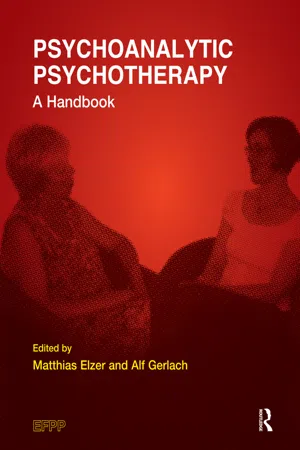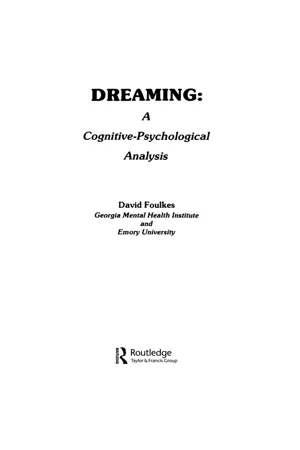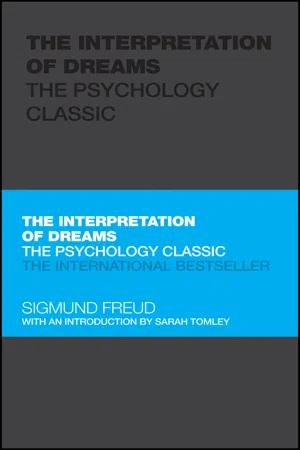Psychology
Dreaming
Dreaming is a complex mental process that occurs during sleep, involving vivid sensory experiences, emotions, and thoughts. It is characterized by the presence of vivid, immersive imagery and a suspension of critical thinking. Dreaming is believed to serve various psychological functions, such as processing emotions, consolidating memories, and problem-solving.
Written by Perlego with AI-assistance
Related key terms
5 Key excerpts on "Dreaming"
- eBook - ePub
The Primordial Mind in Health and Illness
A Cross-Cultural Perspective
- Michael Robbins(Author)
- 2013(Publication Date)
- Routledge(Publisher)
Chapter 6 Dreaming The phenomenon of Dreaming is a central data source for Freud, Jung and Bion’s western cultural models of intrapsychic unconscious mind. Dreaming is important in non-western cultures as well. In spiritual cultures dreams, both sleeping and waking, are viewed as part of the existential spirit world. To begin I review major theories of Dreaming and highlight their strengths and limitations. These can be evaluated in two categories. The first has to do with the relationship of the underlying mental activity to thought. The second has to do with the epistemological perspective of the theorist. Psychoanalytic models tend to view the mental process underlying Dreaming as pathological. And most of them are biased by the perspective of western culture that recognizes and values conscious rational thought and views what is not thought as deficient in the sense of being primitive, immature and unconscious, rather than simply being different. The relationship of Dreaming to thought Hypotheses about the relationship of Dreaming to thought can be grouped into several categories. The work of some theorists falls into more than one. The Dreaming process as an aspect of thought As I described in Chapter 2, Freud composed two theories to account for Dreaming, a conservative one that depicts it as the product of a thought-related symbolic activity, and a radical one that describes it as a unique manifestation of mind. Klein hardly mentioned Dreaming in her work. However, some who followed her have related Dreaming and phantasy, which was described in Chapter 2, as both having characteristics of thought and as being qualitatively different from thought. In some neo-Kleinian writings, including those of Bion (see Chapter 3) and Meltzer, Dreaming is described as a thought-related process. Bion (1962, 1992; Grotstein, 2009) describes Dreaming as a continuous process manifest as states like reverie during wakefulness and Dreaming proper at night - eBook - ePub
Psychoanalytic Psychotherapy
A Handbook
- Matthias Elzer, Alf Gerlach(Authors)
- 2018(Publication Date)
- Routledge(Publisher)
What is dreamed at night must be considered and described as a process that does not end upon awakening in the morning. Dreams are permanently reprocessed and altered. Dreams that are recounted in the clinical situation must be understood as highly selective products. When a dream is reported several times, it becomes evident that parts of the dream are omitted, changed, or even added (new fantasies, experiences, excerpts from other dreams, and transference fantasies play an important role in these processes of substitution).The capacity to dream is not present from birth, but develops parallel to cognitive and emotional development. Foulkes (1999) demonstrated that it takes up to thirteen years of human development for the capacity of Dreaming to be fully developed. Three- to five-year-old children have short, emotionally neutral dreams without complicated actions. The dream ego does not appear in children’s dreams until the age of seven. Thereafter, it takes another 2–3 years until the activity of the dream ego corresponds to those of adult persons. These findings indicate strongly that the dream cannot be seen as a perceptive process, but must be seen as a thought process that is completely dependent on a person’s capability to understand and represent symbolically what goes on in the outside world and how the interactions with important others are experienced and encoded.What has become more and more apparent in recent decades is the relationship between thought activities in the waking state and dream thoughts. High emotional pre-sleep experiences have a strong impact on dream contents (Kramer, 2007). The same author has also demonstrated a mood regulatory function of Dreaming (1993), which means that the mood improves during the night: for example, subjects woke up less depressed than the evening before. This effect was also demonstrated in the context of trauma research, for example by the American psychoanalyst Ernest Hartmann, who has conducted extensive research on dreams and nightmares (1995, 1998). The examples given by Hartmann demonstrate that the dream has a “therapeutic function”. In finding new contexts for everyday life experiences, an initially overwhelming experience that was expressed in a nightmare can gradually be contextualised. During this process, the dreamer experiences the original nightmare more and more differently, enriched with components of everyday life experiences. Thus, the nightmare gradually develops into a more common anxiety dream. As the process continues, even these anxiety dreams are increasingly altered to become normal dream experiences. - eBook - ePub
Dreaming
A Cognitive-psychological Analysis
- David Foulkes(Author)
- 2014(Publication Date)
- Routledge(Publisher)
make dream psychology scientific).In this vein, then, a model of Dreaming will be presented.2 This model isn’t, in absolute terms, terribly well formalized. Its advantages, if any, are only relative: This may be a start toward thinking of Dreaming the way cognitive psychology now thinks of such phenomena as remembering or speaking. Fortunately for you, because it is just a start, the model can be presented fairly simply. We’ll consider the model in three stages: Memory (the knowledge representations reprocessed during Dreaming and the “sources” of dream imagery); Planning (the nonconscious structures that begin to interpret and organize the mnemonic sources of the dream); and Conscious Organization (the imagery and feelings which we consciously apprehend and call the “dream” and which are the results of nonconscious planning at the second level).1. MemoryActivation. The model considers Dreaming to be instigated by diffuse activation in mnemonic systems. That is, it is provoked by elements of memory and knowledge whose insistent and widespread activity calls up the interpretive machinery of the dream-production system. Diffuse activation in memory may result from positive (excitatory) or negative (disin-hibitory) influences. “Positively,” it may reflect increases in general cerebral activation (as during REM sleep). “Negatively,” the diffuseness of mnemonic activation may result from a release from inhibition.For example, relinquishing voluntary self-control may cause increases in the effective strength of mnemonic units whose influence previously has been inhibited by self-regulation. That is, when you’re consciously planning your thought, there are many things you’re keeping out of conscious awareness because they aren’t relevant to whatever plan you’re following. Even while you are consciously planning your thought, you sometimes are aware of dissociated images, words, or thoughts that lie at the edge of the conscious mainstream of your more orderly and planned thinking. Evidently these elements are relatively potent, because if you relax your conscious vigilance even momentarily, they sometimes completely replace your orderly, planned thinking. Dreaming can’t be explained simply as being - eBook - ePub
- Sigmund Freud, A. A. Brill(Authors)
- 2015(Publication Date)
- Dover Publications(Publisher)
40 we are nevertheless able to explain this excitement through the regressive revival of active memories behind the dream. A modest part in our conception has also been assigned to the inner organic sensations which are wont to be taken as the cardinal point in the explanation of the dream. These— the sensation of falling, flying, or inhibition—stand as an ever ready material to be used by the dream-work to express the dream thought as often as need arises.That the dream process is a rapid and momentary one seems to be true for the perception through consciousness of the already prepared dream content; the preceding parts of the dream process probably take a slow, fluctuating course. We have solved the riddle of the superabundant dream content compressed within the briefest moment by explaining that this is due to the appropriation of almost fully formed structures from the psychic life. That the dream is disfigured and distorted by memory we found to be correct, but not troublesome, as this is only the last manifest operation in the work of disfigurement which has been active from the beginning of the dream-work. In the bitter and seemingly irreconcilable controversy as to whether the psychic life sleeps at night or can make the same use of all its capabilities as during the day, we have been able to agree with both sides, though not fully with either. We have found proof that the dream thoughts represent a most complicated intellectual activity, employing almost every means furnished by the psychic apparatus; still it cannot be denied that these dream thoughts have originated during the day, and it is indispensable to assume that there is a sleeping state of the psychic life. Thus, even the theory of partial sleep has come into play; but the characteristics of the sleeping state have been found not in the dilapidation of the psychic connections but in the cessation of the psychic system dominating the day, arising from its desire to sleep. The withdrawal from the outer world retains its significance also for our conception; though not the only factor, it nevertheless helps the regression to make possible the representation of the dream. That we should reject the voluntary guidance of the presentation course is uncontestable; but the psychic life does not thereby become aimless, for we have seen that after the abandonment of the desired end-presentation undesired ones gain the mastery. The loose associative connection in the dream we have not only recognised, but we have placed under its control a far greater territory than could have been supposed; we have, however, found it merely the feigned substitute for another correct and senseful one. To be sure we, too, have called the dream absurd; but we have been able to learn from examples how wise the dream really is when it simulates absurdity. We do not deny any of the functions that have been attributed to the dream. That the dream relieves the mind like a valve, and that, according to Robert’s assertion, all kinds of harmful material are rendered harmless through representation in the dream, not only exactly coincides with our theory of the twofold wish-fulfilment in the dream, but, in his own wording, becomes even more comprehensible for us than for Robert himself. The free indulgence of the psychic in the play of its faculties finds expression with us in the non-interference with the dream on the part of the foreconscious activity. The “return to the embryonal state of psychic life in the dream” and the observation of Havelock Ellis,23 “an archaic world of vast emotions and imperfect thoughts,” appear to us as happy anticipations of our deductions to the effect that primitive modes of work suppressed during the day participate in the formation of the dream; and with us, as with Delage,15 the suppressed - eBook - ePub
The Interpretation of Dreams
The Psychology Classic
- Sigmund Freud, Tom Butler-Bowdon(Authors)
- 2020(Publication Date)
- Capstone(Publisher)
In the bitter and seemingly irreconcilable controversy as to whether the psychic life sleeps at night or can make the same use of all its capabilities as during the day, we have been able to agree with both sides, though not fully with either. We have found proof that the dream thoughts represent a most complicated intellectual activity, employing almost every means furnished by the psychic apparatus; still it cannot be denied that these dream thoughts have originated during the day, and it is indispensable to assume that there is a sleeping state of the psychic life. Thus, even the theory of partial sleep has come into play; but the characteristics of the sleeping state have been found not in the dilapidation of the psychic connections but in the cessation of the psychic system dominating the day, arising from its desire to sleep. The withdrawal from the outer world retains its significance also for our conception; though not the only factor, it nevertheless helps the regression to make possible the representation of the dream. That we should reject the voluntary guidance of the presentation course is uncontestable; but the psychic life does not thereby become aimless, for we have seen that after the abandonment of the desired end-presentation undesired ones gain the mastery. The loose associative connection in the dream we have not only recognised, but we have placed under its control a far greater territory than could have been supposed; we have, however, found it merely the feigned substitute for another correct and senseful one. To be sure we, too, have called the dream absurd; but we have been able to learn from examples how wise the dream really is when it simulates absurdity. We do not deny any of the functions that have been attributed to the dream
Learn about this page
Index pages curate the most relevant extracts from our library of academic textbooks. They’ve been created using an in-house natural language model (NLM), each adding context and meaning to key research topics.




